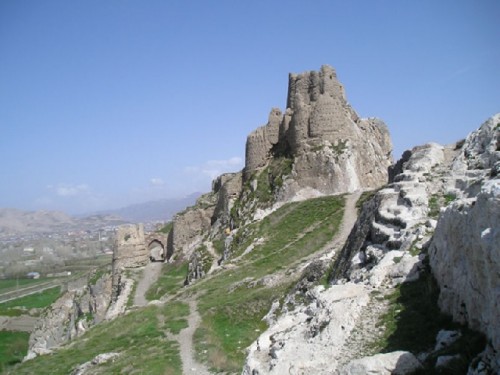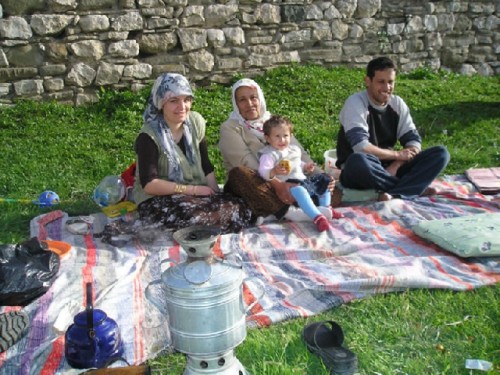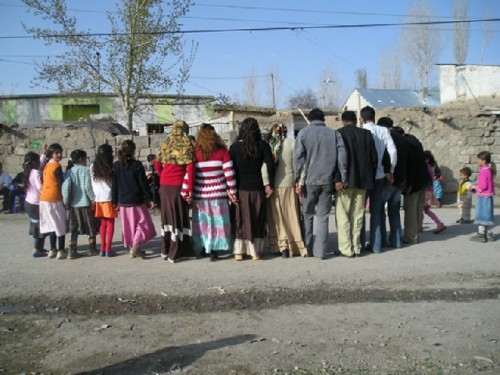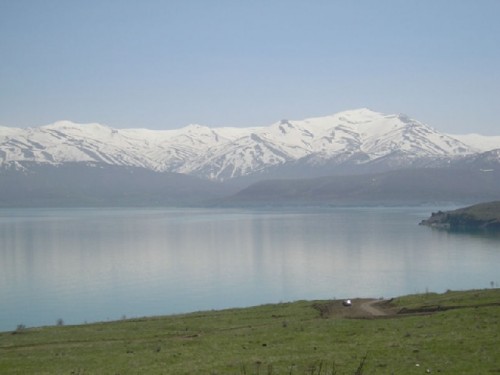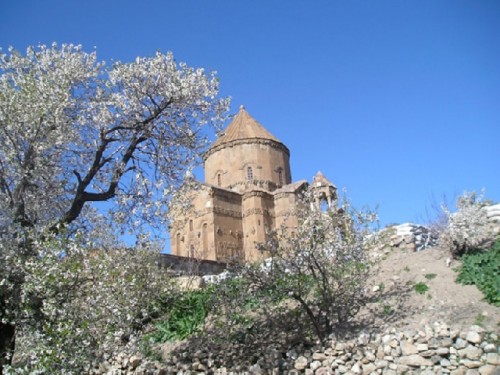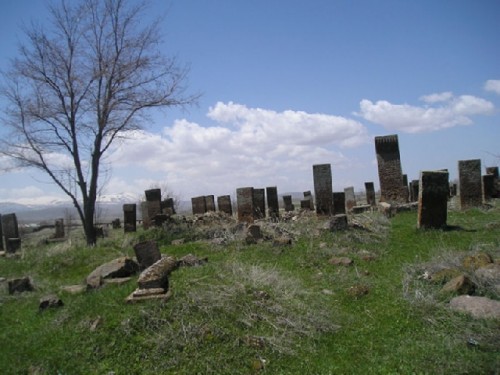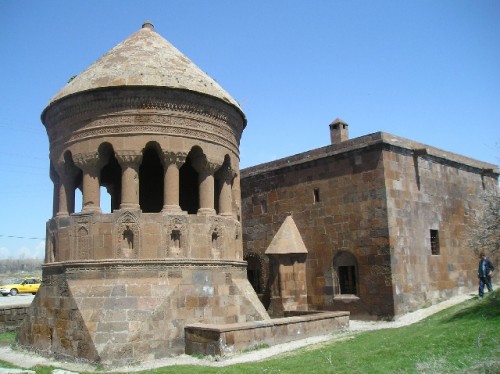Eastern Turkey: Part One
Continuing Prior Coverage
By: Zeren Earls - Aug 19, 2007
Van
Meeting us at the airport, our pre-arranged taxi driver took us to the centrally located Urartu Hotel, our base for five nights during our daily excursions to various parts of the region. Although we had offers from several locals to stay with them, we declined their hospitality to retain our independence. In general Turks are friendly people; yet in the traditional east the hospitality is accentuated because for a Muslim an unexpected guest is considered to have been sent by God. People are quick to invite guests and will share whatever they happen to have, including food. This generosity is also characteristic of Kurds, who make up the majority of the region's population. Our driver, also a Kurd, was with us during our entire trip for a daily fee, in addition to which we paid for gas and lunch.
Van is located at an altitude of 1725 meters on the eastern shore of Lake Van, the world's largest salt lake, 3760 square kilometers in size. Called "the sea" by the locals, it is ringed by snow-capped mountains that are covered by purple and yellow flowers in the spring. We were a little too early to witness this splendor, which takes place from mid-May to mid-June. We began our sightseeing 5 km from the hotel at the Citadel, which is built on a massive rock in old Van called Tushpa, the capital of the Urartu Kingdom. Built in the 9th century BC, the Citadel features rock tombs and some of the oldest Urartian tablets, written in Assyrian cuneiform. The view from the Citadel of the city below and of the sunset is worth the climb, which can take over an hour since paths are sparse and the nimbleness of a goat is necessary to negotiate the rocks.
Inhabited by many civilizations since 4000 BC, Van, in addition to its longest residents, the Urartians, has been home to Hittites, Hurians and Persians, becoming the center of an Armenian kingdom in the first century BC. The series of occupations continued with Medes, Arabs, Seljuk Turks (11th century), Mongols (13th century) and finally Ottoman Turks, who defended it from Persian attack in the 14th century. While the Citadel is the primary ancient ruin in old Van, nearby are two small mosques built by Sinan (16th century). As we were photographing these stone gems of alternating stripes, we were invited by a Kurdish family to have tea. On a cloth spread on the emerald grass we sat with the family (grandmother, son, wife and two-year-old daughter) to enjoy home-baked goods and dates accompanied by tea from their samovar. The tradition of tea drinking is an addiction in the east; people drink many glasses throughout the day. Our camaraderie led to an overnight invitation, which we kindly declined.
Returning to our hotel, we passed by a large sculpture of Van's emblematic white cat known for its eyes with half-blue and half-yellow irises. Indigenous to the city, these cats are known not to survive outside of their natural habitat. They are protected at the University's cat house and may be seen by appointment. In the city center another public piece is of a wrecked car suspended from a fork lift. A large billboard next to it reminds passersby that "Accidents result not from fate, but from carelessness". Driving by the harbor near a tea garden we passed a shooting gallery of balloons floating on the water, a small local enterprise, which my friend supported. Another impromptu stop by the roadside was at a Kurdish wedding party with music and line dancing, which we were welcome to photograph.
At the end of our long day we decided to eat at the hotel and indulged in its buffet spread. In this mountainous region the food is weighted toward meat and dairy products rather than vegetables. Since Van is only 80 km from Iran, there were Persian meatballs and imported watermelon among the selections. The dining room quickly filled up with locals, who had made reservations to watch on a large screen the soccer game between the country's two main rival teams. Soccer in Turkey is a national passion.
Lake Van
In the morning, after a buffet breakfast that included the local flat bread, white cheese with mountain herbs and honey in the comb, we set out on our tour circling the lake, a circumference of 330 km. We followed an inland road north and cleared a military check point before turning in to the coastal road. Proximity to the Iranian border necessitates the checking of IDs to prevent the smuggling of people, drugs and cheap goods, especially gasoline in case they slip by the border patrol. A highway billboard warned drivers, "The difference between 90 and 100 km/hour is the difference between life and death". Nurseries of skinny poplars lined the coastal road set against snow-capped, lush green mountains. Families enjoying a Sunday picnic, all with samovars, dotted the shoreline. Village houses and mosques with shiny aluminum roofs and domes to retain solar heat shimmered in the distance.
Our first stop was in Adilcevaz at the Tugrul Bey Mosque from architect Sinan's early period. As we were admiring its intricate geometric stonework, a bus load of women Iranian tourists in black chadors arrived. On their way to Syria, they were going through Turkey to bypass Iraq. We continued on to Ahlat known for the volcanic reddish-brown stone used in all its buildings. There are over ten tombs made of this stone, some dating back to the 13th century. Most impressive is a Seljuk cemetery in an endless field of headstones, many over two meters high. Arranged in rows, they create an incredible landscape of brown stones of varying shades with ornate bas-reliefs, making for a fascinating stroll.
The edges of Lake Van filled with brown silt from the mountains as we approached Tatvan for a lunch break. We passed by an elementary boarding school for children from distant villages. At Tatvan harbor the car ferry, on its twice weekly four-hour journey to Van, waited to load up the Istanbul-Tehran train as seagulls fluttered above. We walked to a restaurant that specialized in buryani, lamb roasted slowly in a pit fire and served with pita bread. Amazed, I watched waiters call out orders for extra fatty roasts. In addition to what was already on our plates, large round loaves of pita came heaped in big baskets. The amount of bread our driver consumed, like all other locals, was a reminder that this was the basic staple of the land.
The southern route of Lake Van to Gevas was the most picturesque. The road cut through the mountains to a landscape of black goats and white sheep on verdant slopes, of mud houses on the hillside, and veins of ice turning into trickling streams under the glowing sun. We left the car in Gevas and took a boat to the little island of Ahtamar, where there is a tenth century Armenian Church. The 25 minute boat ride runs frequently, leaving when filled with passengers. The almond trees were in full bloom. The impressive church of cut Ahlat stone was a spectacle amidst the flowering white almonds. Planned on a cross, the outside is decorated with designs and bas-reliefs of biblical scenes such as Adam and Eve, David and Goliath, and Jonah. The interior has biblical frescoes. Built by king Gavuk I and completed in six years by stone masters, the building served as a church until the First World War. Now it is a restored historic site.
A Kurdish wedding party from northern Iraq arrived as we descended the steps to the boat for our return. A Kurdish bride is easily distinguished by the amount of gold she wears. The boat quickly filled with locals carrying big bundles of wild plants and herbs that they had gathered to use in cooking or making cheese. The island is an attractive recreation spot for picnicking and swimming. At the boat landing back in Gevas we stopped at the tea garden for the day's obligatory refreshment to keep our driver happy. Nearby we visited the tomb of Halime Hatun, a must see jewel because of its stone work. The last 43 km stretch back to Van went quickly without any stops. Ready to settle for the night, in the hotel's dining room we opted for the a-la-carte menu instead of the buffet. I had a hearty red lentil soup; it was delicious.

